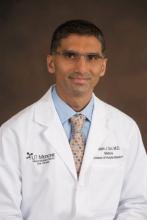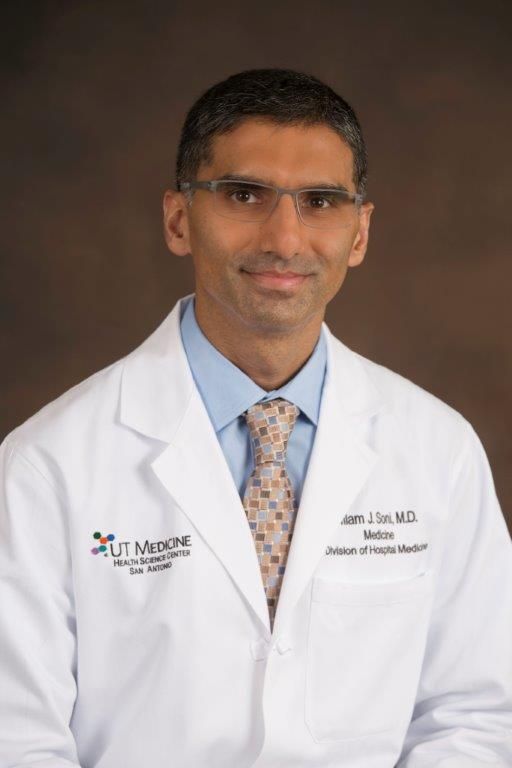User login
Hospitalists and other health care workers will be introduced to the concept of using point-of-care ultrasound to guide bedside diagnostics and clinical decision making at a Sunday pre-course titled “Point-of-Care Ultrasound for the Hospitalist.”
HM19 marks the 10th anniversary of this particular pre-course offering. “It is the SHM annual meeting’s longest-standing pre-course, and it has sold out every year since its inception. Learners always rate it highly,” said course director Nilam J. Soni, MD, MS, associate professor in the department of medicine at the University of Texas, San Antonio. “Faculty members are very experienced and passionate about teaching this innovative technology.”
Dr. Soni said that using portable ultrasound takes clinicians back to the bedside, which is a rarity with new technologies. “It allows clinicians to spend more time with patients, which is fulfilling for the patient and clinician,” he said. “Based on what we’ve seen over the past decade, it can improve hospitalists’ job satisfaction and enjoyment of their clinical work.”
While most medical schools are now introducing point-of-care ultrasound to their medical students, many currently practicing physicians haven’t been trained in using this new technology. This pre-course can help fill that gap.
Although ultrasound technology has existed since the 1940s, large bulky machines weren’t practical for bedside use. Now, ultrasound machines are so small that they can be carried in a coat pocket. “Small machines can be as powerful as some of the larger ones and cost only a few thousand dollars due to increasing market competition,” said Dr. Soni, whose course codirector is Ricardo Franco-Sadud, MD, a hospitalist at Naples (Fla.) Community Hospital. “The availability and portability is driving the uptake of ultrasound.”
In addition to being used at the bedside, ultrasound has other advantages, such as being noninvasive and not emitting radiation like CT scans do.
“It’s time for physicians to have another bedside tool in their black bag,” said Dr. Soni, who notes that the stethoscope is more than 200 years old and human hands and eyes have limitations.
This session will appeal to a mix of attendees. Administrators will gain a better understanding of the multitude of applications of point-of-care ultrasound and how ultrasound can be integrated into their practice. Clinicians will get hands-on experience by practicing a multitude of applications during scanning sessions with live models. Medical educators will glean insight on how to develop training programs and curricula.
“Our goal is to familiarize attendees with using ultrasound for different applications to evaluate common conditions, such as heart failure, pleural effusions, pneumonia, and lower-extremity swelling,” Dr. Soni said.
The pre-course will feature practical and focused lectures combined with hands-on practice sessions. “We’ll start with the basics on how to use ultrasound, then we’ll practicing acquiring images on live models and reviewing normal and abnormal images. We’ll conclude with real patient cases.” Learners will rotate in small groups to different tables where they will practice different skills on varying body parts.
Dr. Soni reports grants from the Department of Veterans Affairs Quality Enhancement Research Initiative Partnered Evaluation Initiative Grant (HX002263-01A1) outside of the submitted work.
Point-of-Care Ultrasound for the Hospitalist
Sunday, 7:30 a.m. – 12:30 p.m. and 1:00 – 6:00 p.m.
Potomac C/1-3
Hospitalists and other health care workers will be introduced to the concept of using point-of-care ultrasound to guide bedside diagnostics and clinical decision making at a Sunday pre-course titled “Point-of-Care Ultrasound for the Hospitalist.”
HM19 marks the 10th anniversary of this particular pre-course offering. “It is the SHM annual meeting’s longest-standing pre-course, and it has sold out every year since its inception. Learners always rate it highly,” said course director Nilam J. Soni, MD, MS, associate professor in the department of medicine at the University of Texas, San Antonio. “Faculty members are very experienced and passionate about teaching this innovative technology.”
Dr. Soni said that using portable ultrasound takes clinicians back to the bedside, which is a rarity with new technologies. “It allows clinicians to spend more time with patients, which is fulfilling for the patient and clinician,” he said. “Based on what we’ve seen over the past decade, it can improve hospitalists’ job satisfaction and enjoyment of their clinical work.”
While most medical schools are now introducing point-of-care ultrasound to their medical students, many currently practicing physicians haven’t been trained in using this new technology. This pre-course can help fill that gap.
Although ultrasound technology has existed since the 1940s, large bulky machines weren’t practical for bedside use. Now, ultrasound machines are so small that they can be carried in a coat pocket. “Small machines can be as powerful as some of the larger ones and cost only a few thousand dollars due to increasing market competition,” said Dr. Soni, whose course codirector is Ricardo Franco-Sadud, MD, a hospitalist at Naples (Fla.) Community Hospital. “The availability and portability is driving the uptake of ultrasound.”
In addition to being used at the bedside, ultrasound has other advantages, such as being noninvasive and not emitting radiation like CT scans do.
“It’s time for physicians to have another bedside tool in their black bag,” said Dr. Soni, who notes that the stethoscope is more than 200 years old and human hands and eyes have limitations.
This session will appeal to a mix of attendees. Administrators will gain a better understanding of the multitude of applications of point-of-care ultrasound and how ultrasound can be integrated into their practice. Clinicians will get hands-on experience by practicing a multitude of applications during scanning sessions with live models. Medical educators will glean insight on how to develop training programs and curricula.
“Our goal is to familiarize attendees with using ultrasound for different applications to evaluate common conditions, such as heart failure, pleural effusions, pneumonia, and lower-extremity swelling,” Dr. Soni said.
The pre-course will feature practical and focused lectures combined with hands-on practice sessions. “We’ll start with the basics on how to use ultrasound, then we’ll practicing acquiring images on live models and reviewing normal and abnormal images. We’ll conclude with real patient cases.” Learners will rotate in small groups to different tables where they will practice different skills on varying body parts.
Dr. Soni reports grants from the Department of Veterans Affairs Quality Enhancement Research Initiative Partnered Evaluation Initiative Grant (HX002263-01A1) outside of the submitted work.
Point-of-Care Ultrasound for the Hospitalist
Sunday, 7:30 a.m. – 12:30 p.m. and 1:00 – 6:00 p.m.
Potomac C/1-3
Hospitalists and other health care workers will be introduced to the concept of using point-of-care ultrasound to guide bedside diagnostics and clinical decision making at a Sunday pre-course titled “Point-of-Care Ultrasound for the Hospitalist.”
HM19 marks the 10th anniversary of this particular pre-course offering. “It is the SHM annual meeting’s longest-standing pre-course, and it has sold out every year since its inception. Learners always rate it highly,” said course director Nilam J. Soni, MD, MS, associate professor in the department of medicine at the University of Texas, San Antonio. “Faculty members are very experienced and passionate about teaching this innovative technology.”
Dr. Soni said that using portable ultrasound takes clinicians back to the bedside, which is a rarity with new technologies. “It allows clinicians to spend more time with patients, which is fulfilling for the patient and clinician,” he said. “Based on what we’ve seen over the past decade, it can improve hospitalists’ job satisfaction and enjoyment of their clinical work.”
While most medical schools are now introducing point-of-care ultrasound to their medical students, many currently practicing physicians haven’t been trained in using this new technology. This pre-course can help fill that gap.
Although ultrasound technology has existed since the 1940s, large bulky machines weren’t practical for bedside use. Now, ultrasound machines are so small that they can be carried in a coat pocket. “Small machines can be as powerful as some of the larger ones and cost only a few thousand dollars due to increasing market competition,” said Dr. Soni, whose course codirector is Ricardo Franco-Sadud, MD, a hospitalist at Naples (Fla.) Community Hospital. “The availability and portability is driving the uptake of ultrasound.”
In addition to being used at the bedside, ultrasound has other advantages, such as being noninvasive and not emitting radiation like CT scans do.
“It’s time for physicians to have another bedside tool in their black bag,” said Dr. Soni, who notes that the stethoscope is more than 200 years old and human hands and eyes have limitations.
This session will appeal to a mix of attendees. Administrators will gain a better understanding of the multitude of applications of point-of-care ultrasound and how ultrasound can be integrated into their practice. Clinicians will get hands-on experience by practicing a multitude of applications during scanning sessions with live models. Medical educators will glean insight on how to develop training programs and curricula.
“Our goal is to familiarize attendees with using ultrasound for different applications to evaluate common conditions, such as heart failure, pleural effusions, pneumonia, and lower-extremity swelling,” Dr. Soni said.
The pre-course will feature practical and focused lectures combined with hands-on practice sessions. “We’ll start with the basics on how to use ultrasound, then we’ll practicing acquiring images on live models and reviewing normal and abnormal images. We’ll conclude with real patient cases.” Learners will rotate in small groups to different tables where they will practice different skills on varying body parts.
Dr. Soni reports grants from the Department of Veterans Affairs Quality Enhancement Research Initiative Partnered Evaluation Initiative Grant (HX002263-01A1) outside of the submitted work.
Point-of-Care Ultrasound for the Hospitalist
Sunday, 7:30 a.m. – 12:30 p.m. and 1:00 – 6:00 p.m.
Potomac C/1-3

